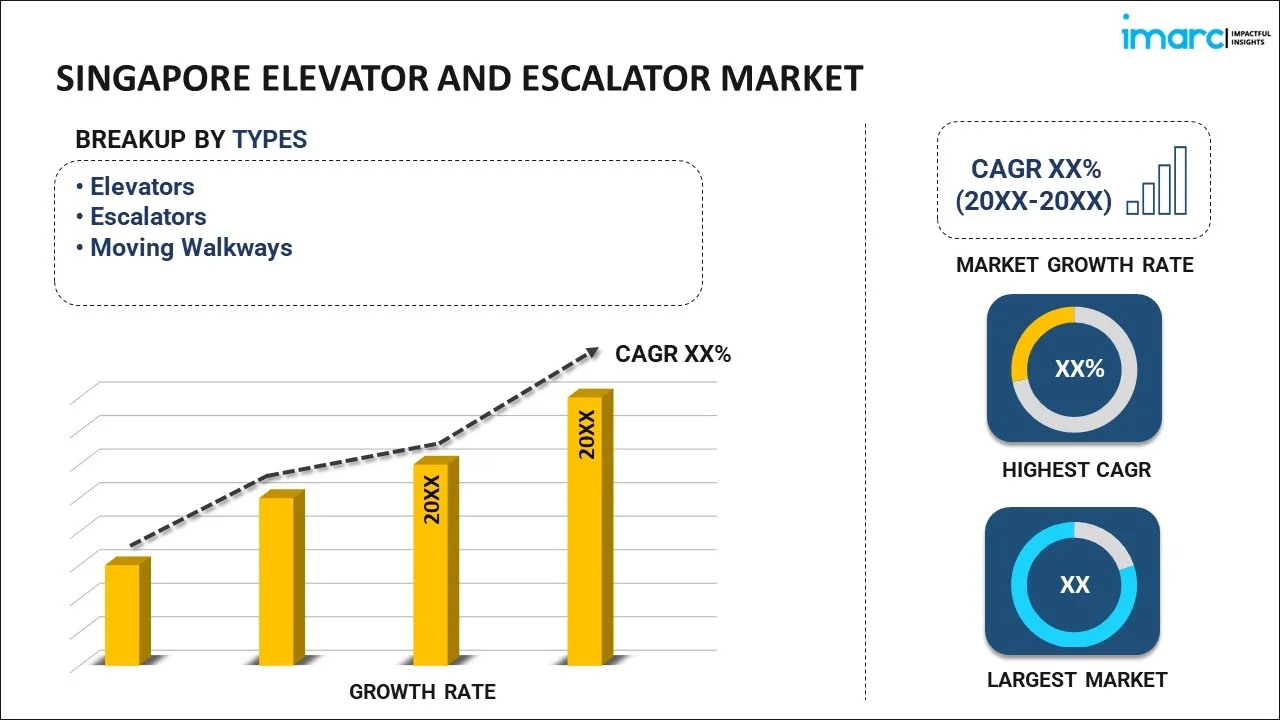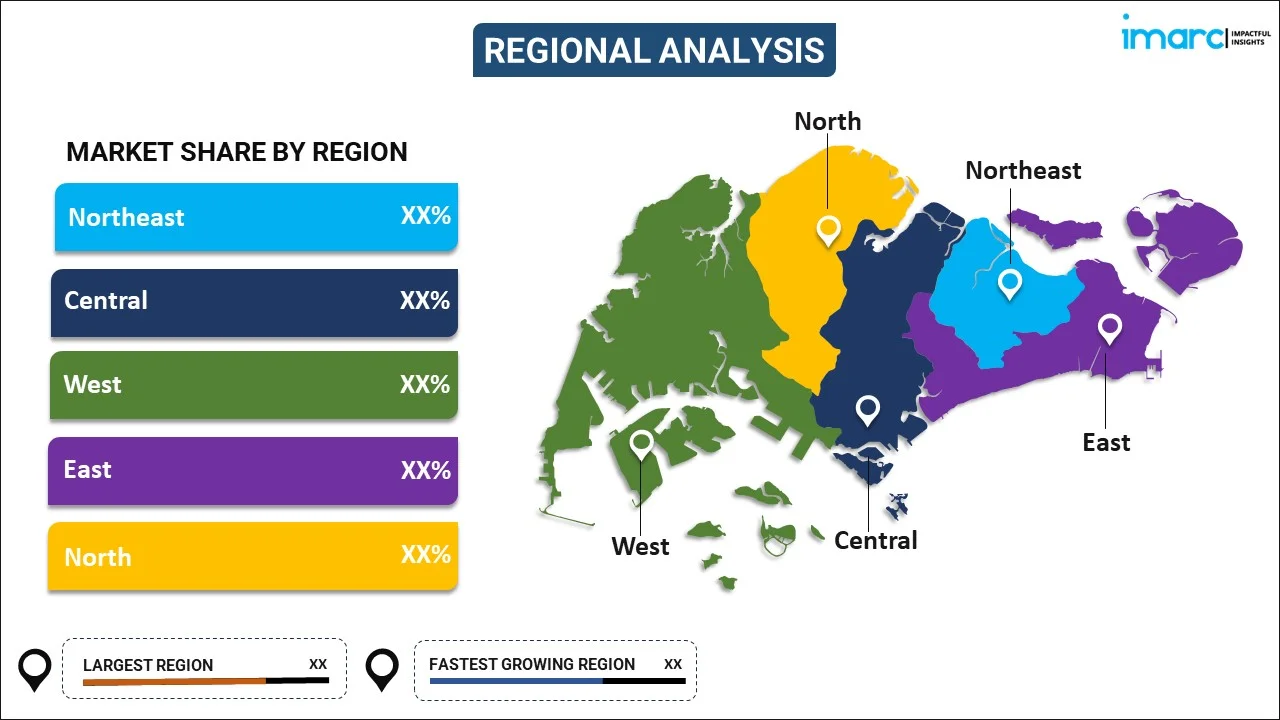
Singapore Elevator and Escalator Market Report by Type (Elevators, Escalators, Moving Walkways), Service (New Installation, Modernization, Maintenance and Repair), End Use (Residential, Commercial, Industrial), and Region 2024-2032
Singapore Elevator and Escalator Market Overview:
The Singapore elevator and escalator market size is projected to exhibit a growth rate (CAGR) of 5.60% during 2024-2032. Increasing urbanization, trends towards high-rise construction, modernization of aging infrastructure, favorable government infrastructure projects, ongoing technological advancements, supportive safety regulations, and the rising need for energy-efficient vertical transportation solutions are some of the key factors propelling the market growth.
|
Report Attribute
|
Key Statistics
|
|---|---|
|
Base Year
|
2023 |
|
Forecast Years
|
2024-2032
|
|
Historical Years
|
2018-2023
|
| Market Growth Rate (2024-2032) | 5.60% |
Singapore Elevator and Escalator Market Trends:
Rapid urbanization and development of high-rise buildings
Singapore continues to experience a surge in urban development projects, including residential, commercial, and mixed-use skyscrapers. The limited land availability necessitates vertical expansion, leading to a growing demand for elevators and escalators to ensure efficient vertical transportation. New high-rise developments in areas such as Marina Bay, Orchard Road, and the Central Business District require advanced elevator and escalator systems that offer high-speed reliability and safety. In addition to this, supportive government initiatives aimed at promoting sustainable urban development, such as the Urban Redevelopment Authority's (URA) master plans are further contributing to the market growth. As Singapore continues to grow vertically, the need for sophisticated vertical transportation solutions is bolstering the market demand.
Advancements in smart and energy-efficient technologies
The adoption of Internet of Things (IoT) and artificial intelligence (AI) technologies in elevator and escalator systems is transforming the industry by enhancing performance, safety, and maintenance efficiency. Additionally, energy-efficient technologies, such as regenerative drives and light-emitting diode (LED) lighting, are becoming standard features in new installations and modernization projects. These technologies help reduce energy consumption and contribute to Singapore's sustainability goals. Moreover, the integration of smart technologies in elevators and escalators facilitates seamless connectivity with building management systems, allowing for better resource management and enhancing the overall operational efficiency of buildings. As smart city initiatives and green building certifications become more prevalent, the demand for advanced, energy-efficient elevator and escalator solutions will continue to grow, thereby strengthening the market growth.
Modernization of aging infrastructure
Many buildings in Singapore, including public housing, commercial properties, and institutional facilities, were constructed several decades ago and now require upgrades to meet current safety standards and improve efficiency. Large-scale renovation projects have been started by the Housing and Development Board (HDB) and other organizations to improve the older buildings' usability, safety, and accessibility. Modernization projects often involve retrofitting existing elevators and escalators with the latest technologies, such as destination control systems, advanced safety features, and energy-efficient components. These upgrades are essential to extend the lifespan of the equipment, reduce maintenance costs, and improve user experience. The ongoing efforts to modernize the built environment in Singapore are presenting lucrative opportunities for market expansion.
Singapore Elevator and Escalator Market News:
- In April 2023, Elevator World magazine honored Otis Worldwide Corporation's projects in its annual Project of the Year awards. Otis claimed victory in the Escalators category for major rail infrastructure projects. Within this, Singapore's MRT East-West and North-South lines won for modernization.
Singapore Elevator and Escalator Market Segmentation:
IMARC Group provides an analysis of the key trends in each segment of the market, along with forecasts at the country level for 2024-2032. Our report has categorized the market based on type, service, and end use.
Type Insights:

- Elevators
- Escalators
- Moving Walkways
The report has provided a detailed breakup and analysis of the market based on the type. This includes elevators, escalators, and moving walkways.
Service Insights:
- New Installation
- Modernization, Maintenance and Repair
A detailed breakup and analysis of the market based on the service have also been provided in the report. This includes new installation and modernization, maintenance and repair.
End Use Insights:
- Residential
- Commercial
- Industrial
The report has provided a detailed breakup and analysis of the market based on the end use. This includes residential, commercial, and industrial.
Region Insights:

- North-East
- Central
- West
- East
- North
The report has also provided a comprehensive analysis of all the major regional markets, which include North-East, Central, West, East, and North.
Competitive Landscape:
The market research report has also provided a comprehensive analysis of the competitive landscape. Competitive analysis such as market structure, key player positioning, top winning strategies, competitive dashboard, and company evaluation quadrant has been covered in the report. Also, detailed profiles of all major companies have been provided.
Singapore Elevator and Escalator Market Report Coverage:
| Report Features | Details |
|---|---|
| Base Year of the Analysis | 2023 |
| Historical Period | 2018-2023 |
| Forecast Period | 2024-2032 |
| Units | Billion US$ |
| Scope of the Report | Exploration of Historical Trends and Market Outlook, Industry Catalysts and Challenges, Segment-Wise Historical and Future Market Assessment:
|
| Types Covered | Elevators, Escalators, Moving Walkways |
| Services Covered | New Installation, Modernization, Maintenance and Repair |
| End Uses Covered | Residential, Commercial, Industrial |
| Regions Covered | North-East, Central, West, East, North |
| Customization Scope | 10% Free Customization |
| Post-Sale Analyst Support | 10-12 Weeks |
| Delivery Format | PDF and Excel through Email (We can also provide the editable version of the report in PPT/Word format on special request) |
Key Questions Answered in This Report:
- How has the Singapore elevator and escalator market performed so far and how will it perform in the coming years?
- What has been the impact of COVID-19 on the Singapore elevator and escalator market?
- What is the breakup of the Singapore elevator and escalator market on the basis of type?
- What is the breakup of the Singapore elevator and escalator market on the basis of service?
- What is the breakup of the Singapore elevator and escalator market on the basis of end use?
- What are the various stages in the value chain of the Singapore elevator and escalator market?
- What are the key driving factors and challenges in the Singapore elevator and escalator?
- What is the structure of the Singapore elevator and escalator market and who are the key players?
- What is the degree of competition in the Singapore elevator and escalator market?
Key Benefits for Stakeholders:
- IMARC’s industry report offers a comprehensive quantitative analysis of various market segments, historical and current market trends, market forecasts, and dynamics of the Singapore elevator and escalator market from 2018-2032.
- The research report provides the latest information on the market drivers, challenges, and opportunities in the Singapore elevator and escalator market.
- Porter's five forces analysis assist stakeholders in assessing the impact of new entrants, competitive rivalry, supplier power, buyer power, and the threat of substitution. It helps stakeholders to analyze the level of competition within the Singapore elevator and escalator industry and its attractiveness.
- Competitive landscape allows stakeholders to understand their competitive environment and provides an insight into the current positions of key players in the market.
Need more help?
- Speak to our experienced analysts for insights on the current market scenarios.
- Include additional segments and countries to customize the report as per your requirement.
- Gain an unparalleled competitive advantage in your domain by understanding how to utilize the report and positively impacting your operations and revenue.
- For further assistance, please connect with our analysts.
 Inquire Before Buying
Inquire Before Buying
 Speak to an Analyst
Speak to an Analyst
 Request Brochure
Request Brochure
 Request Customization
Request Customization




.webp)




.webp)












